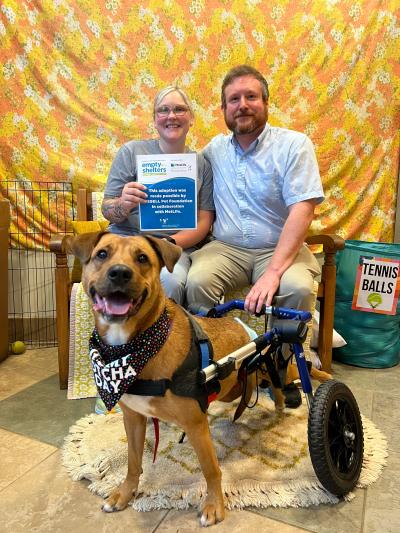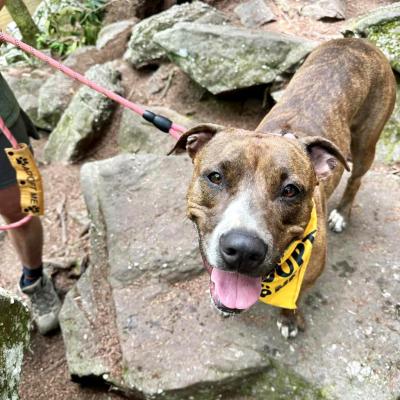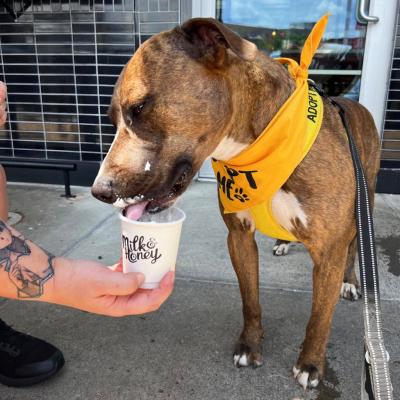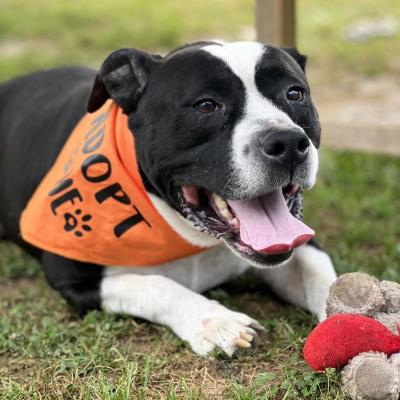Shelter helps dogs put their best paws forward

Lately, dogs have been facing significant challenges in shelters, and even puppies and small purebred dogs are taking longer to be adopted. So when McKamey Animal Center (MAC) rescued Ward, a dog who uses a wheelchair and who can’t go to the bathroom on his own, they knew they’d need to go the extra mile to find him a home.
“We believe he got hit by a car,” says Lauren D. Mann, CNP, MNM, director of advancement at the Chattanooga, Tennessee-based shelter. “Even though he was paralyzed from the waist down, he pulled himself to safety under a parked car. Since he arrived, he has been the definition of the word resilience — so much so that we call him Ward the Wonder Dog.”
Nick Walton, senior manager of national shelter support at Best Friends, became familiar with Ward’s story on a recent visit. Best Friends’ national shelter support team works with our partners on programs that help them save more animals. Providing this kind of one-on-one support is one of the ways Best Friends is helping shelters reach no-kill by 2025. Nick was there to work with MAC staff on supporting dogs in their care with more activities to keep dogs happy and more relaxed while in their kennels.
During his time there, Nick was both impressed by Ward’s resilient spirit and aware of the challenge to find a home able to accommodate the intensive care the dog required. But he also had faith that if any shelter could succeed, it was MAC.
[Lifesaving soars with new shelter practices]
“It was a really sad situation for Ward, who is just the friendliest goof you've ever met,” Nick says. “On the other hand, Best Friends has worked with MAC for long enough to know that they are a real powerhouse of a shelter.
“They have built out a number of great canine-focused programs, which are critical right now when shelters everywhere are struggling to find homes for the dogs in their care,” Nick adds. “When shelters have dogs with behavioral issues or medical challenges like Ward has, it's not enough to just place them up for adoption. Shelters need to pull out all the stops.”
For Ward, the program that clinched a home was MAC’s Slumber Paw-ty foster program.
“We featured him all over our social media, but it took nearly six months before we were contacted by a family who wanted to meet him,” Lauren says. “They knew about his challenges up front, and they were pretty much sold on him. However, they wanted to be sure they could manage his needs in their home, and the Slumber Paw-ty program was a perfect opportunity to find out if they could.”
The program allows people to take an adoptable dog home for a few nights, so they can see whether they’re a good fit. Ward’s potential adopters were more than happy to take advantage of the program. And after three days, they returned to MAC and made things official.
“Since they adopted him, we have gotten a bunch of updates,” Lauren says. “He is starting to walk and stand on his own, and he is wagging his tail, too. It’s just incredible. Our whole staff cried watching the video of his tail wagging.”

Let’s have a Slumber Paw-ty
MAC began offering its Slumber Paw-ty program last Thanksgiving, and it quickly become a favorite.
“We've had quite a few adoptions from it,” Lauren says. “It’s perfect for people who are on the fence about making a commitment. Giving them an opportunity to see a dog in their house for a couple days and integrate him into their life — that’s a much different experience than just spending 20 minutes with him in a room here.”
Even if it’s not the right match, the dogs who go on a Slumber Paw-ty come back with more information about their true personalities.
“Sleepovers are never failures because we're learning about the dog in a home environment,” Lauren says. “Being able to share details like the fact that a dog likes to sleep at the foot of the bed just makes him more adoptable.”

Taking dogs out for a day of work or play
There are all kinds of benefits to getting dogs out of the shelter, and MAC’s K9 to 5 program has been a great opportunity for people to spend eight hours of quality time with an adoptable dog.
“It’s geared towards businesses and allows people who have pet-friendly offices to check out a dog for the day,” Lauren says. “We have quite a few business partners in town that participate, and we give them marketing perks in exchange by listing them on our website. If they tag us in social media photos, we'll reshare those on our social, too.”
The program has been helpful for the types of dogs who tend to take longer to get adopted, such as the big ones whom some classify as “pit bull terrier types” — dogs like Nathan, a “big black-and-white pittie-type dog who doesn’t get a second glance here,” Lauren says.
“He’s a really well-behaved dog who is also a big ham,” she says. “He loves belly rubs and just wants to snuggle.”
[Kansas animal shelter staff sees dogs in a new light]
Though the K9 to 5 program has certainly generated its share of adoptions, Nathan wasn’t adopted during his day out. Nonetheless, Lauren feels the experience definitely played a role in him finding a home.
“One day after he came back from hanging out in an office for hours, he was just so chill and relaxed,” she says. “That attracted the attention of a number of visitors, including a family who fell in love with this big mellow dog and ended up adopting him.”
Another outing-based program, Trailblazers, is designed to take advantage of the unique offerings in the Chattanooga area.
“We are known as the scenic city because we sit in a fishbowl surrounded by mountains with many hiking trails,” Lauren says. “Since we attract a lot of outdoorsy people, we created Trailblazers so that people can check out a dog for some outside activity. People can take the dogs anywhere that is dog-friendly, but the program is really geared to help those animals with a lot of excess energy to burn.”
Jinx is one dog who is practically a poster child for Trailblazers.
“She's just overstimulated and amped up in her kennel, behavior that can appear to be aggressive,” explains Nick. “Really, though, her behavior is situational. By participating in Trailblazers, she has been able to show everyone what a sweet, go-getter dog she really is once she gets outside of the stressful shelter environment.”
[Wisconsin shelter helps troubled dogs into homes]
Jinx has really blossomed thanks to her time spent outside of the shelter. When she comes back from her outings, she is worn out and relaxed (much like Nathan was). That is helping her feel better in the shelter environment while she’s there. Trailblazers also revealed a fun special interest for Jinx: playing in water.
“She loves water more than anything, so now she gets pool time every day,” Lauren says.
Nick stresses that such discoveries add another level of benefits.
“MAC was able to craft enrichment specific to what Jinx likes,” he says. “As a result of these activities, shelter staff can share really robust information about who she is and show videos of her behavior outside. Jinx still needs a home, but her participation in multiple programs at MAC is keeping her happy and healthy until someone falls in love with her.”

MAC Cares Fund offers families a hand during hard times
MAC also focuses on ways to keep dogs with their families during challenging times, rather than the dogs being relinquished. The MAC Cares Fund has been invaluable in accomplishing this aim. The fund was developed after the shelter’s experience with a dog named Lilo, who arrived as a stray dog with a note attached to her collar.
“Her person felt she had no other option than to give her up because she had two children and was experiencing homelessness,” Lauren says.
MAC used its social platforms to put out a message letting Lilo’s person know that they would do everything possible to reunite the family. Lilo’s person came forward after seeing the message, and the shelter continued to work with her on solutions to keep them together. The story went viral on an international scale, and they raised so much money that they decided to set up a permanent fund to help families and pets experiencing similar circumstances. Since MAC launched the fund, they have helped more than 20 families who were going through hard times to keep their animals.
“The response to Lilo’s post (on social media) was something we never anticipated,” Lauren says. “Our team was truly blown away. Since we set up the fund, every case we have been able to help has been so worth the time and energy it takes to come up with solutions for sometimes very challenging issues.”

Keeping the public involved
MAC staff aren’t content to sit on their laurels when it comes to dreaming up ways to help the animals in their care. Plans are underway to build a garden on the shelter grounds. The first phase will be a memorial garden, and the second comprises enrichment and sensory elements.
“We will be converting one of our biggest play yards into different pathways for the dogs to walk on, and there will interactive elements like things the dogs can climb on and a water feature,” Lauren says. “We will also grow edible plants that volunteers can turn into treats on site, including catnip for the kitties.”
As is the case for all of MAC’s programs, involving the public is key.
“When people take time to show the dogs to their co-workers, they are heroes for those animals,” Lauren says. “Spending the day out with one of our dogs is like being a walking billboard, and that's huge when it comes to finding homes for them.”
Nick stresses that information is vital when it comes to solving what is currently a national crisis for many dogs.
“Dogs like Jinx who get labeled as having ‘behavior problems’ are particularly at risk,” Nick says. “By getting as much information as possible about who these dogs really are, we are giving them more of a chance to get out of the shelter alive and become part of a family.”
Just as Nick was sure that MAC would find a family for Ward, he is also confident that their dog programs will succeed in saving lives — both inside their shelter walls and beyond.
“MAC has been a longtime, pivotal powerhouse in the South,” he says. “They are a leader in animal sheltering, and it’s only a matter of time before other shelters in the region mirror some or all of what they are doing. Someday soon, the many Wards, Nathans, and Jinxes sitting in shelters of all sizes will have happy outcomes as well.”






